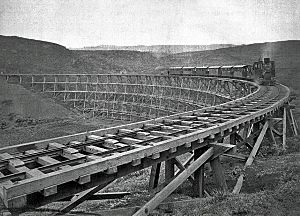Mahukona facts for kids
Māhukona was once a small town on the island of Hawaiʻi. There's also an old, underwater volcano called Māhukona, located offshore to the south, which is named after this area. The town was famous for being the end point of the Hawaiian Railroad.
The Story of Māhukona
Māhukona was an old Hawaiian land area called an ahupuaʻa. This land stretched from the bay all the way up to the slopes of Kohala mountain. A long time ago, much of this land belonged to Princess Ruth Keʻelikōlani. The name "Māhukona" means "leeward steam" in the Hawaiian language. Today, Lapakahi State Historical Park is just south of Māhukona. You can find the harbor right off Akoni Pule Highway, which is Hawaii Route 270.
Building the Railroad
In 1880, Samuel Gardner Wilder was a government official, like a secretary of the interior. He helped start a railroad company. The very first sugarcane farm in the Kohala area began in 1863, started by Elias Bond. But it was hard to move the sugarcane from the farms to the ships.
Wilder had an idea: he wanted to build a railroad. This railroad would carry sugarcane from the wet, windy side of Kohala to Māhukona. From Māhukona, ships could easily pick up the sugar. Wilder already owned a steamship company, so he built a pier at Māhukona harbor.
Work on the railroad began in 1881. The first part of the track opened in 1882. By 1883, the railroad stretched about 20 miles (32 km). It reached the Niuliʻi sugar farm, but then it hit a big obstacle: the Pololū Valley.
Wilder named the first train engine "Kinaʻu" after his wife. He hoped to extend his railroad all the way to Hilo. However, this didn't happen until after he passed away, when the Hawaii Consolidated Railway built it. The two railroads never connected as Wilder had hoped. In 1897, the railroad company changed its name to the Hawaii Railway Company, Ltd. Sugar companies bought it in 1899.
Life in the Town
A sugar mill was built on the north side of Māhukona Bay. You can still see its remains today. A bigger wharf (a place for ships to dock) was built in 1911. However, a storm immediately destroyed it, so it had to be rebuilt.
By 1913, Māhukona was the fourth busiest port in the Hawaiian islands. Even so, only 13 ships entered the harbor that year. The first lighthouse was built in 1889, just south of the bay. In 1915, a new concrete pyramid-shaped lighthouse, 22 feet (6.7 m) tall, replaced it.
By 1937, all the sugar operations in Kohala moved to the mill at Māhukona. The company became Mahukona Terminals Ltd. In 1941, the port closed because of World War II. The railroad officially closed on October 29, 1945.
Māhukona Today
The town of Māhukona once had about 40 families living there. But it was abandoned in the 1950s. In 1956, the harbor was closed for good.
Today, Māhukona Bay is a park managed by Hawaii County. It's called Māhukona Beach Park, but the shoreline is mostly rocky and doesn't have a sandy beach. It's a great spot for fishing, snorkeling, picnics, and camping.
In the 1990s, a company planned to build a golf course and resort in the area. The company changed its name to the Kohala Preserve Conservation Trust, LLC. However, many local residents were against the project. There's even an old song about Māhukona, which means "sugar boiler," that was recently recorded.


